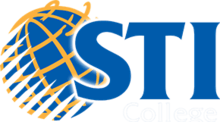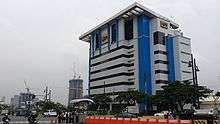STI College
STI College, formerly known as Systems Technology Institute, is the largest network of for-profit information technology based colleges in the Philippines. This private college system offers a curriculum including accountancy and business administration, and computer science. The acronym STI has been declared as an orphan initialism after their name change in 2006.
Kolehiyong STI | |
 STI College | |
| Motto | "Education For Real Life" |
|---|---|
| Type | Private, for-profit studies (PSE: STI) |
| Established | August 21, 1983 |
| Chairman | Eusebio H. Tanco [1] |
| President | Monico V. Jacob (also Chief Executive Officer)[2] |
| Students | 62,500 nationwide |
| Undergraduates | 13,200 a year |
| Location | Bonifacio Global City, Taguig, Philippines |
| Campus | Multiple campuses nationwide |
| Colors | Yellow, blue & white |
| Mascot | Globe |
| Website | www |
STI uses a trimester calendar as opposed to the typical semester collegiate education program mostly used by Philippine universities. It has branches all over the Philippines and claims to be the second largest IT-based educational institution in Asia.[3]

Ownership
STI College is wholly owned by the STI Education Services Group, Inc. (STI ESG), a subsidiary of the STI Education Systems Holdings, Inc. of Dr. Eusebio "Yosi" H. Tanco, PhD from the Tanco Group (parent company of STI Education Systems Holdings, Inc.). Tanco also serves as the majority and principal owner of the STI Investments, Inc., another subsidiary of the STI Education Systems Holdings, Inc.[4]
History
STI was a former computer center organized in 1983, when entrepreneurs Augusto C. Lagman, Herman T. Gamboa, Benjamin A. Santos and Edgar H. Sarte set up the Systems Technology Institute to train people in programming and IT. At first there were two schools, and now there are more than 70.
Programs include information and communications technology, engineering, health care, accountancy, business & management, hospitality and tourism management.[5]
In 2006, the acronym of STI no longer stands as Systems Technology Institute because it offers not just Technology and Science courses, but also Health, Arts, Managements, Businesses, Hospitality, and Culinary, albeit that up to this present time though, IT and CS courses are still the largest population in the institution. The initials STI therefore has been orphaned and becomes a pseudo-acronym.
DLS - STI College and MMCC
In 2002, STI obtained a majority share in De los Santos College to create the DLS-STI College of Health Professions. In 2006, they acquired a stake in the De Los Santos Medical Center, now known as De Los Santos - STI Medical Center.[6]
On October 2013, STI Health Professionals, Inc., a subsidiary of STI Education Systems Holdings, Inc. and operator of De Los Santos-STI, purchased Makati Medical Center College from Medical Doctors, Inc. through its sister school PWU. PWU was in a joint venture arrangement with STI at the time. That arrangement has since ended and PWU has sold Makati Medical Center College.
Other branches/campuses

Some of STI's campuses nationwide uses various STI brand names. The Group (STI ESG, Inc.) also owns and operates two non-STI branded colleges and manages one newly acquired university.
Other higher education institutions owned by STI
- iAcademy
- STI West Negros University (STI WNU)
See also
- List of universities and colleges in the Philippines
- Academia Education Systems Holdings, Inc. (stylized as academia) registered on the Philippine Stock Exchange
Other higher education institutions in the Philippines of similar type:
References
- "Company Overview of Asian Terminals Inc. – Executive Profile: Eusebio H. Tanco Ph.D."
- "Company Overview of STI Education Systems Holdings, Inc. – Executive Profile: Monico V. Jacob".
- http://www.sti.edu. "STI Colleges and Education Centers". Sti.edu. Retrieved 2013-09-14.
- "Company Overview of STI Investments Inc".
- http://www.sti.edu. "STI Colleges and Education Centers - Education for Real Life". Sti.edu. Retrieved 2013-09-14.
- "STI, De los Santos hospital merge". Archived from the original on 2007-11-09. Retrieved 2008-03-29.